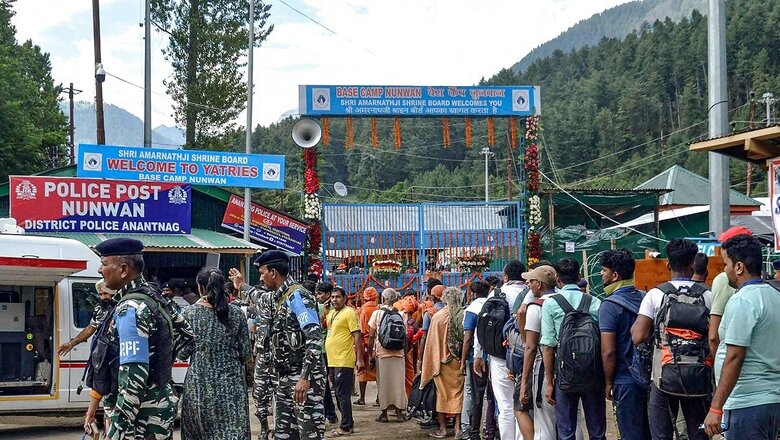
views
This year’s Amarnath Yatra started from Jammu on Wednesday, with the first batch of pilgrims commencing their journeys on Friday amid multiple-layers of security.
The first batch of over 3,400 pilgrims left for for the twin base camps in Kashmir to undertake the pilgrimage.
What is the Amarnath Yatra?
The Amarnath Yatra is a pilgrimage on the twin tracks of the traditional 48-km Nunwan-Pahalgam route in Anantnag district and the 14-km shorter but steep Baltal route in Ganderbal district.
The annual pilgrimage, considered holy in the Hinduism, is located at a 3,880-metre-high holy cave shrine of Amarnath in the south Kashmir amid Himalayas.
Amarnath is considered to be one of the holiest shrines of Lord Shiva.
The Yatra takes places in the Shravan month of the Hindu calendar and this is the only time that the caves are accessible to general public. The yatra will last till August 31 this year.
Amarnath Yatra set to commence, more than 3,000 pilgrims arrive at Pahalgam in Jammu and Kashmir@Ieshan_W gets you this report#AmarnathYatra #JammuKashmir pic.twitter.com/CQSkCIsCUR— News18 (@CNNnews18) June 30, 2023
Why is this year’s Amarnath Yatra significant?
This year’s yatra will last for 62 days, and is the longest-ever one till now.
This year’s yatra is significant as it is expected to see over 6 lakh pilgrims. Over three lakh people have already registered for the journey till Wednesday. The number of registrations so far, is 10 per cent more than last year, the shrine board said.
Increased security measures this year
As the Yatra’s terrain is arduous, unfortunate accidents are common during the journey.
A major change this year is that the security teams stationed at the cave shrine have received mountain warfare training. The Central Central Reserve Police Force (CRPF) has been replaced by the mountain-warfare trained personnel of the Indo-Tibetan Border Police (ITBP).
The CRPF will now be present just below the stairs of the cave shrine, even as the ITBP and Border Security Force (BSF) will guard about half-a-dozen camps that were earlier guarded by the CRPF, the lead internal security force of the country.
Senior officers of Jammu and Kashmir Police, CRPF, BSF, Indian Army and Indo-Tibetan Border Police (ITBP) reviewed the security arrangements at the holy cave as well as along the traditional route to the shrine.
The use of drones, apart from the traditional methods of securing the yatra routes has been inculcated , besides using search-and-rescue dogs at all places, including near the cave shrine, in order to respond quickly in case of a natural or man-made disaster.
Routes made safer
To make the pilgrimage safer, this year both routes have been made better. The tracks of the yatra have been widened and hand railings have been installed for better safety.
Apart from this, at vulnerable points of the journey, helmets have been kept so that the pilgrims can protect themselves from shooting stones and landslides during heavy rains.
Mountain rescue teams have been deployed en-route the cave shrine for quick evacuation in case of emergencies, CEO of Shri Amarnath Shrine Board (SASB) Mandeep Kumar Bhandari said.
To avoid a situation like the flash flood last year — that killed 15 people — no devotee will be allowed to stay near the cave shrine during night time.
More facilities at the yatra this year
There is a makeshift state-of-the-art hospital, built by DRDO at Chandanwari, that will help in round-the-clock healthcare facilities to the pilgrims. Medical officers will keep the health facilities available 24/7.
Moreover, there will be telecom services available on the entire route, in which OFC cables have been laid on both the tracks by service providers. This is to ensure that internet facility and telecom facility are available at all times.
At least 5,100 separate toilets have been set up for this year’s yatra by a joint initiative of the shrine board, Rural Development Department, various municipal corporations, and development authorities.
















Comments
0 comment